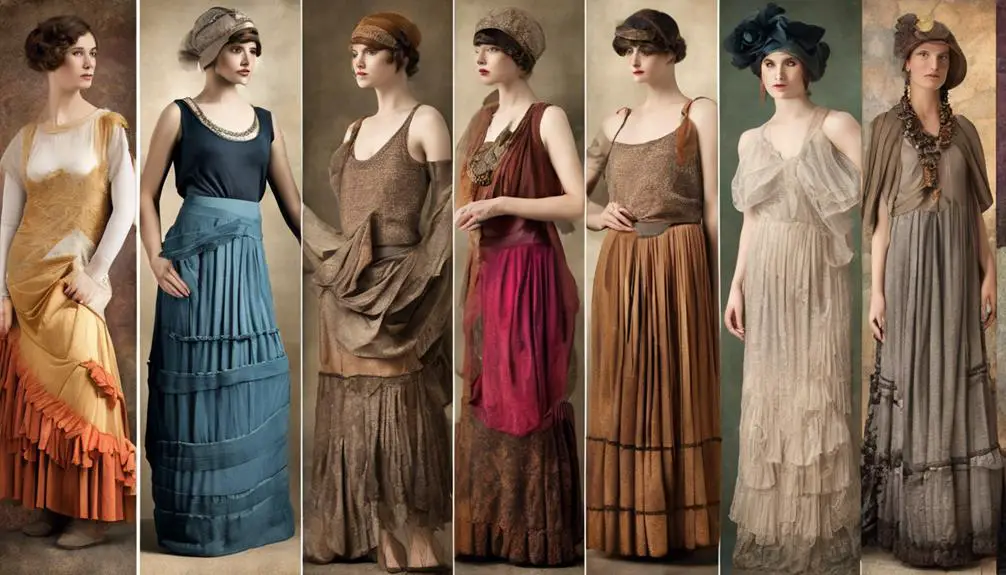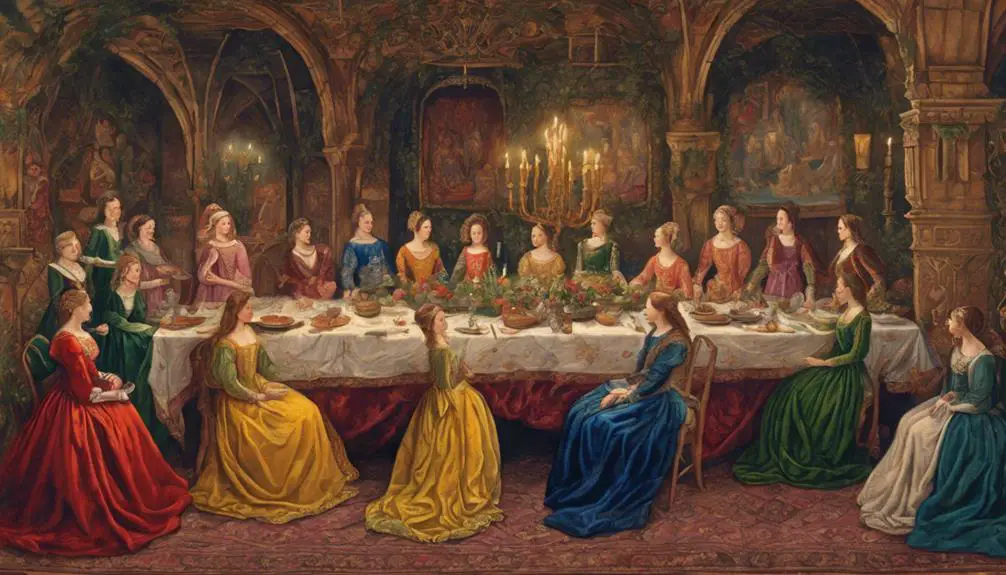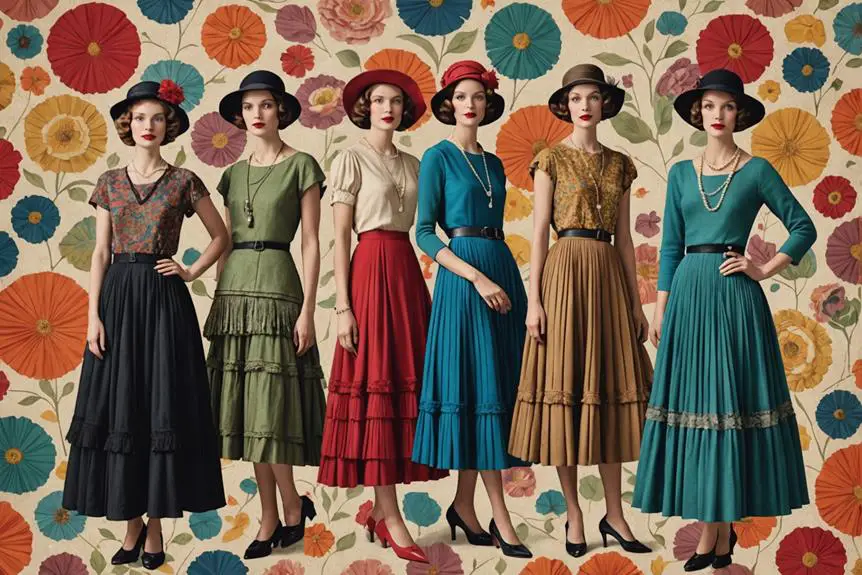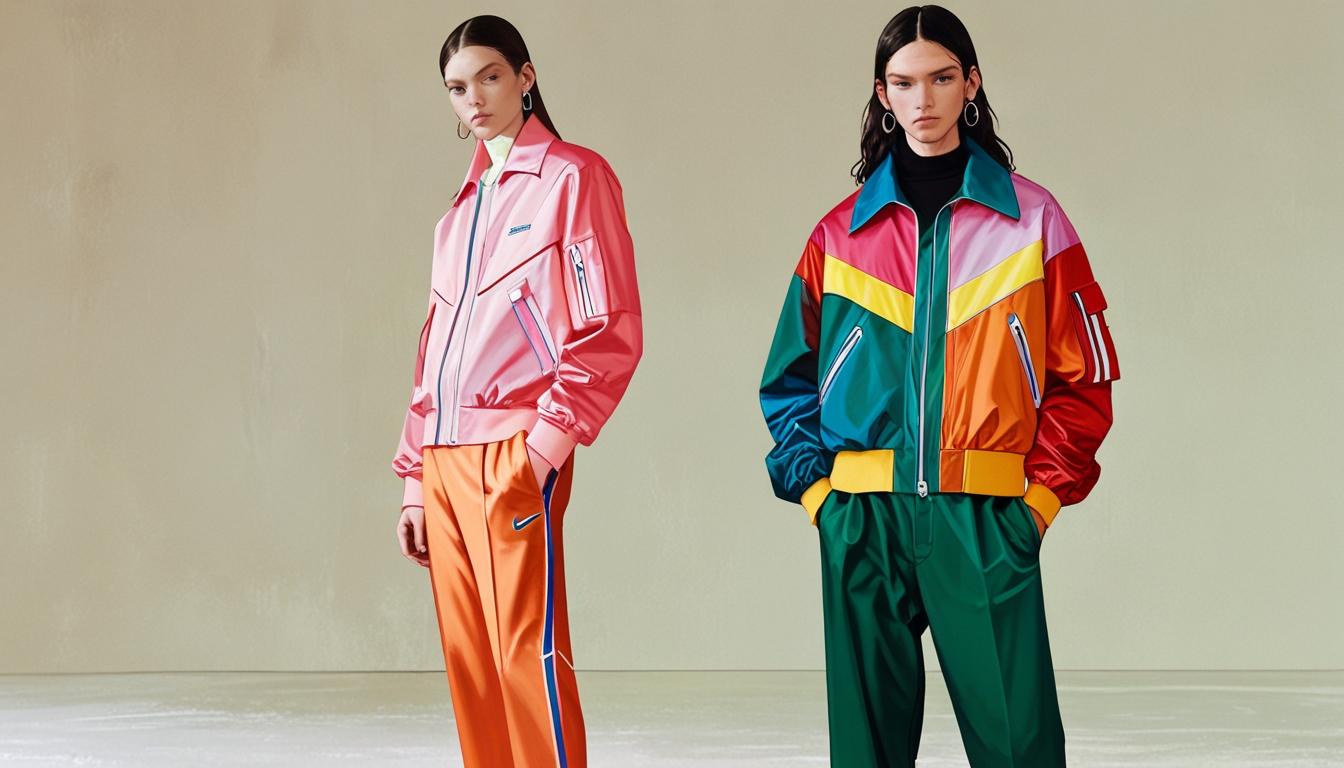Imagine walking through a bustling ancient Egyptian marketplace, where men proudly wore shendyt skirts, a symbol of status and practicality. As you explore the evolution of skirts through the ages, you'll discover how these garments have shifted from utilitarian designs to expressions of identity and cultural significance. Each era brought its own interpretations, reflecting changing societal norms and fashion trends. What do these transformations reveal about our understanding of gender and identity today?
Historical Overview of Skirts

Skirts have been an essential part of human attire for millennia, evolving considerably over time. Can you imagine how skirts have transformed from ancient times to now? Let's take a quick journey through history!
Back in ancient Egypt, skirts weren't just for women; men wore them too! The shendyt skirt, made from local flax, was a popular choice, with styles reflecting social status. In modern times, the importance of sustainability has made vintage skirts increasingly valuable, as they often carry a rich history and unique style that can't be replicated by fast fashion, promoting emotional and sustainable fashion. Fast forward to the Middle Ages, when skirts were mostly dress-like garments. But then, men started wearing tailored trousers, and skirts took a backseat for a while.
Things took a dramatic turn during the Victorian era. Oh boy, did skirts get fancy! They ballooned out thanks to crinolines and bustles, making quite the statement. But by the late 1800s, practicality kicked in, and fashion started shifting towards more manageable separates.
Now, let's zoom into the 20th century! This was a game-changer for skirts. The 1960s brought us the miniskirt, a daring and bold garment that shook up women's fashion. Can you believe how much freedom it represented? Skirts began to reflect personal style more than ever, with a variety of lengths and designs popping up.
Ancient Egyptian Skirts
What did the ancient Egyptians wear to combat their scorching climate? You might be surprised to learn that skirts played a significant role! The Shendyt, a type of skirt, was primarily worn by men in ancient Egypt. Made from locally sourced flax, these skirts were perfect for staying cool in the heat. They varied in length, depending on the wearer's social standing. Wealthier individuals often opted for lighter, finer fabrics, while laborers usually stuck to simpler cotton loincloths.
Women, on the other hand, favored floor-length dresses, typically white. This choice symbolized purity and showcased their social status through fabric quality. Isn't that fascinating? The skirts and dresses were often adorned with decorative elements, like beads and embroidery, making them not just practical but also a way to express personality and wealth.
As time went on, the design and fabric of skirts in ancient Egypt evolved. Cultural practices and the status of the wearer influenced these changes. For instance, if you were a pharaoh, you might have a more elaborate design than a farmer! It's amazing to think about how much a simple piece of clothing can tell us about a person's life back then.
Skirts in the Middle Ages

In the Middle Ages, skirts took on a whole new vibe, and you'd definitely notice the changes! Men were rocking shorter tunics for ease, while women flaunted longer skirts that hugged their shapes and showcased their status. With fancy layers and stylish designs, skirts not only reflected the times but also set the stage for how we think about fashion today—how cool is that?
Skirt Design Changes
During the Middle Ages, skirt design underwent significant changes that mirrored the era's societal norms and gender roles. You'd notice that women wore long, structured dresses that hugged the lines of their bodies, while men sported shorter, skirt-like garments for better mobility. As time went on, many men shifted to tailored trousers and tights by the late Middle Ages, showing how fashion evolved alongside practicality.
Advancements in weaving technology played a big role in this change. They allowed for more intricate designs and comfortable fits in skirt construction. Nobility flaunted layered skirts made from rich fabrics and adorned with embellishments, while the lower classes opted for simpler styles—talk about a fashion divide!
Gender Clothing Norms
Skirts in the Middle Ages reflected the rigid gender clothing norms of the time, with distinct styles for men and women. Can you imagine men strutting around in shorter skirts? It was all about practicality and mobility! But as time went on, trousers and tights began to creep into men's wardrobes, shifting those clothing norms and pushing skirts to the sidelines.
Women, on the other hand, wore fuller and longer skirts that highlighted femininity and modesty. These designs weren't just about looks; they showed off status and wealth, especially among the nobility. Thanks to advancements in weaving technology, skirts became more structured and elaborate, making them even more desirable.
Fashion Evolution and Trends
Fashion has evolved dramatically over the years, reflecting societal changes and shifting attitudes toward femininity. Think about it! In the early 1900s, skirts were all about high waists and long lines, but as time went on, we saw a shift to natural waistlines. Skirts widened, and then came the fabulous 1920s, where shorter skirts became a symbol of the flapper culture. It was all about freedom and modern femininity! To keep these vintage pieces looking their best, proper care is essential, especially for unique fabrics and styles that require specific washing techniques like washing vintage skirts. But don't get too comfy—by the 1930s, longer, elegant styles made a comeback.
Then came World War II, which brought wartime fabric restrictions, leading to a trend of shorter skirts once again. The 1960s exploded with the iconic miniskirt, changing the game forever. Talk about a bold statement! Today, modern skirts reflect a mix of vintage styles and new designs. Isn't it cool how fashion trends cycle back? You can rock a retro look one day and a sustainable, eco-friendly skirt the next.
Celebrity culture and social movements are huge influences on skirt designs too. They drive innovation and diversity, making every collection unique. So, whether you're into classic cuts or the latest trends, there's a skirt out there for you. Just remember to have fun with your fashion choices! What's your favorite skirt style? Embrace the evolution, and let your personality shine!
Cultural Significance and Gender Norms

Skirts are more than just a piece of clothing; they've long been tied to ideas about femininity and how we think about gender. While some cultures embrace skirts for men, like the kilt in Scotland, others showcase unique styles like the kimono or saree. Isn't it exciting to see how fashion is shifting, making space for everyone to express themselves with skirts, regardless of gender?
Symbolism of Femininity
Throughout history, the symbolism of femininity has often been intricately tied to the design and use of skirts in Western cultures. Skirts have historically symbolized femininity, shaping societal views on women's roles. Think about it—larger skirts in the past showed wealth and status, thanks to those fancy fabrics! But skirts aren't just for women; take the kilt in Scotland or the tupenu in Tonga, where men rock skirts too. Isn't that interesting?
The miniskirt, which took off in the 1960s, became a game-changer, representing youth liberation and the feminist movement. It challenged the idea that skirts were just about being feminine and opened up a world of new possibilities for women's clothing and autonomy.
Today, contemporary designers like Christian Siriano are breaking down gender stereotypes in fashion. They promote skirts as a versatile garment for everyone, regardless of gender. How cool is that? So, whether you're flaunting a flowy maxi or rocking a sleek miniskirt, remember—you're part of a bigger story. Skirts are about expression, freedom, and challenging norms. Let's celebrate that!
Traditional Attire Variations
Many cultures around the world showcase traditional skirt-like garments that hold deep cultural significance and reflect unique gender norms. For instance, in Western cultures, skirts became a symbol of femininity, while other cultures embrace different styles. Take the Scottish kilt, for example. This tartan beauty is worn by men and represents heritage, often making an appearance at formal events. Isn't it cool how it flips the script on what we think of as traditional attire?
Then there's the Indian saree, which features a draped skirt component that's both beautiful and intricate. It showcases cultural pride and femininity across regions. And let's not forget the Japanese hakama—a pleated skirt worn over a kimono, adding elegance during special occasions.
As contemporary fashion evolves, we see a shift in these gender norms. Skirts are now embraced in diverse styles for everyone! Whether it's a simple pleated skirt or a bold design, self-expression is key. So, next time you see someone rocking a skirt, remember—it's more than just clothing; it's a celebration of culture, identity, and a little rebellion against the ordinary! How awesome is that?
Gender Fluidity in Fashion
Fashion's evolving landscape now embraces gender fluidity, challenging traditional norms surrounding clothing. Skirts, once seen as strictly feminine, are now rocking the wardrobes of all genders. How cool is that? Take Scottish kilts, for instance—they're a proud example of a masculine skirt, proving that cultural pride can defy Western expectations.
Designers like Christian Siriano are leading the charge for inclusivity, creating collections that celebrate self-expression for everyone. And let's not forget about high-profile figures like Billy Porter, who strut their stuff in skirts to challenge societal norms and advocate for gender equality in fashion.
But it's not just about the runway. Legal battles over dress codes in schools and workplaces show that people are pushing for rules that allow diverse expressions of identity. Why should anyone be stuck in outdated ideas about what to wear?
As fashion continues to evolve, embracing gender fluidity opens doors to creativity and self-discovery. So, whether you're eyeing that stylish skirt or simply want to express who you are, remember: fashion isn't just about clothes; it's about celebrating you!
Contemporary Skirt Styles and Lengths
Contemporary skirt styles offer a diverse array of lengths and designs, making it easy to find the perfect fit for any occasion. Whether you're heading to a casual outing or a formal event, there's a skirt style just for you! Mini skirts, which typically end above the knee, keep things fun and flirty. Want something a bit more versatile? Midi skirts fall between the knee and ankle, giving you a chic look that works for day or night. If you feel like making a statement, maxi skirts reach all the way to the ankles or even the floor. You can even incorporate unique elements like lace trims or pleated details to elevate your look, similar to how one might enhance a vintage boho dress with decorative embellishments for vintage dress inspiration.
Now, let's talk about shapes! A-line skirts are fitted at the waist and flare out, creating a flattering silhouette that suits all body types. Pencil skirts, on the other hand, hug your curves tightly and are perfect for showing off your figure—ideal for professional settings. If you're feeling adventurous, high-low skirts with their asymmetrical hem add a modern twist, making you stand out in a crowd.
And don't forget pleated skirts! These beauties come with folds that add texture and volume, making them a favorite for both casual outings and dressier events. So, which style are you leaning towards? With so many options, you're bound to find a skirt that reflects your personality and keeps you looking fabulous. Embrace the modern era of skirts, and enjoy experimenting with all the styles out there!
Frequently Asked Questions
What Is the Origin of Skirts?
Skirts originated as ancient clothing, reflecting cultural significance and gender roles. Their textile evolution showcases regional variations and artistic representations, evolving with fashion trends while adapting to historical context and societal norms through the ages.
When Did Skirts Become Feminine?
You'll find skirt fashion evolved through centuries, reflecting cultural significance and gender norms. By the late 19th century, societal perceptions shifted, making skirts a symbol of female identity, personal expression, and fashion revolutions with varying lengths and fabric choices.
What Does the Skirt Symbolize?
A skirt symbolizes individual identity and gender expression, reflecting cultural significance and fashion evolution. Through historical context and societal norms, it serves as artistic representation and a tool for feminist movements in modern interpretations.
Why Did Women's Skirts Get Shorter?
"Less is more" reflects how cultural shifts, economic factors, and feminism influence skirt lengths. Fashion trends, youth culture, and celebrity impact reshape societal norms, promoting body image confidence and seasonal styles through textile innovations, leading to shorter skirts.




